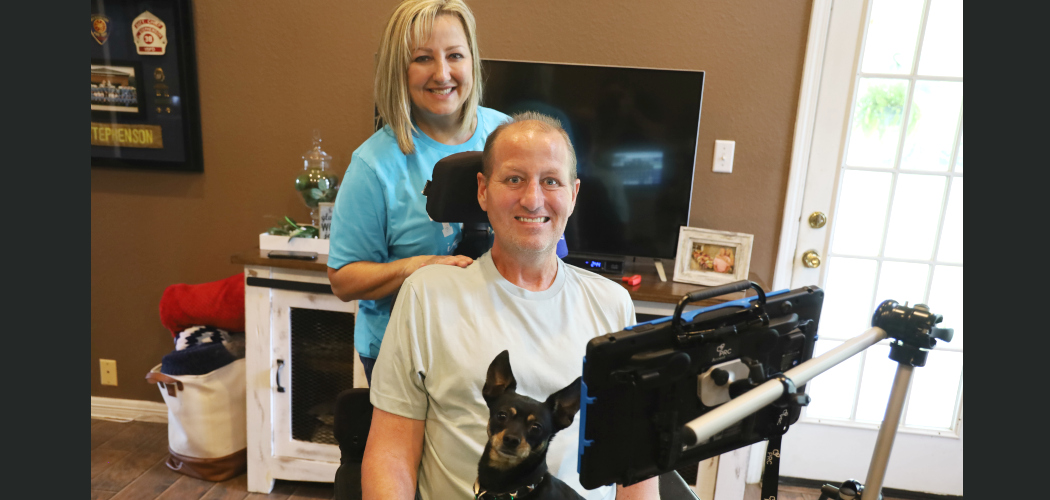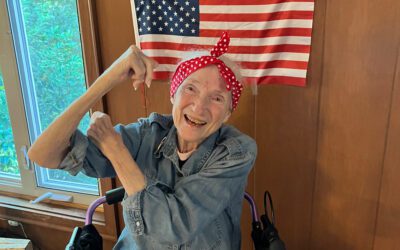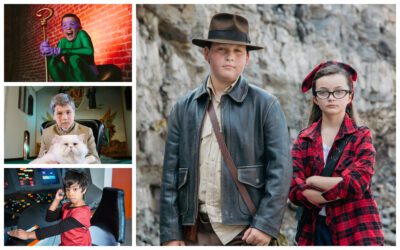[title subtitle=”WORDS Dwain Hebda
IMAGES Dwain Hebda and courtesy Susan Stephenson “][/title]
Les Stephenson’s eyes scan the room like a hummingbird. They’re a window to his soul, providing subtitles to what the former fire battalion chief is thinking at any given moment. His gaze isn’t the only way he communicates but ever since he lost the ability to speak, a byproduct of amyotrophic lateral sclerosis (ALS), the eyes have been key, turning from sparkling to haunting in a breath.
“I’m here,” they seem to say. “I’m still IN HERE.”
Susan Stephenson knows his looks with an almost telepathic understanding. It’s a skill that at its core has less to do with Les’ condition than their nearly thirty years of marriage. But ever since his diagnosis two-and-a-half years ago, ALS has sharpened those senses, even on days when her knees buckle under the weight of it all.
“You just have to have respect for each other,” she says. “We’ve always had that. We’ve never been one to argue and fight in front of people. We didn’t. I mean, we did get into little spats, but then it’d be over with. “We cry a lot. You know, I’ll cry, and get on a crying spell, and he’ll ask me why. I’m like, ‘You know why: life.’ And he’ll do the same thing because he feels like he’s a burden to me, which he’s not. You’re not. It’s not a burden.”
****
ALS, commonly known as Lou Gehrig’s Disease, is a progressive neurodegenerative disease affecting the nerve cells in the brain and spinal cord. The disease robs people of muscle movement, leading to the loss of various body systems and ultimately death. About 16,000 people in the U.S. have the disease at any given time with 5,000 new cases diagnosed per year.
After Les was diagnosed, he and Susan connected with the ALS Association Arkansas Chapter which proved a godsend of information and connections to assistive technology, the most recent of which is a computer setup which allows Les to type by focusing his gaze on keys of a keyboard on the screen. By this laborious process, Les provided insight into living with the killer inside his own body.
“My ALS started with slight weakness in my left hand and arm,” Les says. “It has spread through the rest of my body in two-and-a-half years. It also has taken my voice. I am still able to transfer, with the help of my wife, into my wheelchair and recliner. This is huge. I also eat and breathe on my own. It is very frustrating not to be able to do things for yourself. I rely on my wife for most everything. She does so without complaining. She is my angel.
“I still struggle coming to grips with my diagnosis. I want to fight and win this battle. I am a very sore loser! LOL. I know that miracles happen every day, so I expect a miracle for all living with ALS. Until that happens all we can do is live life. We have today, my wife often reminds me.”
As a career firefighter, Les says he tried to provide a good role model for others to look up to. He hopes to have that effect now, inspiring other families in the same situation to have hope and providing insight as to what lies ahead. “You have to stay one step ahead of this disease,” he says by way of advice. “There is a huge possibility that you will need to make your home more accessible. Don’t wait until you need to do it, go ahead and do it. It takes time to acquire some things. Also, contact your local ALS Association chapter. They are a tremendous help and have tons of information about ALS.”
Like a lot of patients, Les is frustrated at the glacial pace by which promising ALS drugs move through the FDA approval process. He says red tape unnecessarily prohibits people facing a death sentence from trying something, anything, that might help.
“It is very frustrating to see the rush they have put on COVID- 19, a disease that is less than one percent fatal, while the FDA drags their feet on a disease that has no treatment and is one hundred percent fatal and has been around one hundred and fifty years,” he says. “There are four to five drugs or therapies that have already been proven safe and slows progression. In some cases, it has stopped progression. One particular stem cell study called NurOwn reversed some of the symptoms of a Russellville man. NurOwn has been in trials ten years.
“Meanwhile, during that same period good patients lost their lives. How wrong is that? I like to use the analogy, since I was a firefighter, if I pulled up to a burning building and it was in the beginning phase of the fire but sat there and waited until someone who was savable perished, more than likely I would face manslaughter charges. Is that any different than what the FDA is doing? I think not!”
****
Les and Susan first laid eyes on each other in tenth grade at Alma High School. Les had just switched schools and with just one look, Susan saw her future. “When I was like, sixth or seventh grade, I was shy. Real shy,” she says. “The first time I met him, I ran away from him. I remember all my friends had boyfriends. I was like, ‘Lord, I don’t even have to have a boyfriend, just send me the right guy. I just need the right guy.’ “I always tell him that he’s my answered prayer. When I saw him, I was like, ‘I’m gonna date that guy.’ I knew he was the one. I just knew.”
Susan shares these memories in the couple’s living room, a home that sits just a couple doors down from where Les grew up and where family still abounds, kin both of blood and spirit. “Our church family, Kibler Baptist, has just been unbelievably amazing,” Susan says. “They’re just down the road. They were actually just here at noon; we had a whole choir out there from one-year-olds all the way up to, probably forty. They came over and sang. They were going around to people who are shut in. We’ve been here, shut in, for a while.”
The Stephenson’s church family has done more than entertain; they’ve collected money to help fund various treatments and just keep things running. ALS patients and their families are well-versed on the official story line about the disease: no cure, two to five years average life expectancy, and one hundred percent fatal. But from there, many families write their own story, connecting to networks that report on promising treatments or clinical studies all over the world.
The Stephensons are one such family, traveling to China, Costa Rica, Miami and the Mayo Clinic for trials and various therapies. None of them have helped much, but both say it beats letting the disease take you out without a fight. “The thing is, once you get diagnosed, all you do is wait for progression,” Susan says. “The doctors aren’t helpful at all. There’s no hope given to you once you’ve been diagnosed. That’s why we tried to start going to these other places, just to hope that something might help slow the progression or stop it or reverse it.
“My thing is, ALS is fatal, so you have people willing to say, ‘I don’t care, just let me try it. What’s the alternative?’ It’s all just out-of-the-box thinking. It cost lots of money, but we got a lot of donations and Les was like, ‘I want to use them. I want to try.’”
She looks at her husband and sees his eyes rimmed with tears. Back in high school, Susan warded off a rival suitor by fist fighting the other girl into submission. (“Well, we fought. I didn’t say I laid her out,” she says. “You know how girls do. Meeeow! Pulling hair. She broke my necklace.”) Susan didn’t quit that fight and damned if she’ll quit this one.
“Our faith is the main thing. Without that, you have no hope. Right, Les?” she says. “Eventually, I’m going to be gone, too. I tell him all the time it could be me first. Just live every day and find the joy in every day. And he has been! The last couple days have been great.”
“Don’t cry,” she chides, gently.
***
A few years ago, scientists determined the human eye could detect a single candle flame from up to a mile-anda-half away, provided the night was dark enough. It’s an apt metaphor for the Stephenson’s perspective as they work through the biggest challenge of their lives. “He’s lucky because he has me every day,” Susan says with a chuckle as Les smiles. “I tell him, you could stay in a funk all the time.
But, why? When we first wake up, I say, ‘OK, there’s nothing to be sad about right now. Let’s be happy.’ I just believe you live one day at a time and just be happy because there’s something to be happy for every day.”
“I get joy out of being around my family, Susan and my boys Caleb and Cole,” Les adds. “I have several great nieces and nephews who come visit. This brings me great joy. I also enjoy watching birds, squirrel and deer. I have a wonderful support system: family, church, coworkers, friends and community.
“I really try to hang onto hope. There are several promising treatments in the pipeline, we just need them approved. This disease has taught me to cherish every single day. You give yourself time to be sad, angry, etc., but don’t stay in that moment for long. Enjoy life. Enjoy the things you can still do and find new things to enjoy. Don’t let ALS beat you.”
To learn more about ALS and how you can help, visit webar.alsa.org.
The ALS Association Arkansas Chapter | 479.621.8700
1200 West Walnut Street, Suite 2406-08, Rogers, AR 72756




